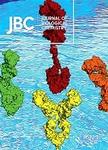版权所有:内蒙古大学图书馆 技术提供:维普资讯• 智图
内蒙古自治区呼和浩特市赛罕区大学西街235号 邮编: 010021

作者机构:Duke Univ Med Ctr Howard Hughes Med Inst Dept Med Durham NC 27710 USA Duke Univ Med Ctr Howard Hughes Med Inst Dept Biochem Durham NC 27710 USA
出 版 物:《JOURNAL OF BIOLOGICAL CHEMISTRY》 (生物化学杂志)
年 卷 期:2000年第275卷第15期
页 面:11312-11319页
核心收录:
学科分类:0710[理学-生物学] 071010[理学-生物化学与分子生物学] 07[理学]
基 金:NHLBI NIH HHS [HL16037] Funding Source: Medline NIDDK NIH HHS [DK55524] Funding Source: Medline
主 题:抑制蛋白类/生理学 催化域 细胞系 动力蛋白质类 胞吞作用 GTP磷酸水解酶类/代谢 磷酰化 蛋白酪氨酸激酶类/化学 蛋白酪氨酸激酶类/生理学 受体 肾上腺素能β2/代谢 构效关系 酪氨酸/代谢 src同源域 src族激酶类 人类
摘 要:beta-Arrestins can act as adapter molecules, coupling G-protein-coupled receptors to proteins involved in mitogenic as well as endocytic pathways. We have previously identified c-SRC as a molecule that is rapidly recruited to the beta 2-adrenergic receptor in a beta-arrestin1-dependent manner, Recruitment of c-SRC to the receptor appears to be involved in pathways leading to receptor internalization and mitogen-activated protein kinase activation. This recruitment of c-SRC to the receptor involves an interaction between the amino-terminal proline-rich region of beta-arrestin1 and the Src homology 3 (SH3) domain of c-SRC, but deletion of the proline-rich domain does not totally ablate the interaction. We have found that a major interaction also exists between beta-arrestin1 and the catalytic or kinase domain (SH1) of c-SRC, We therefore hypothesized that a catalytically inactive mutant of the isolated catalytic subunit, SH1 (kinase dead) (SH1(KD)), would specifically block those cellular actions of c-SRC that are mediated by beta-arrestin1 recruitment to the G-protein-coupled receptor. In contrast, the majority of cellular phosphorylations catalyzed by c-SRC, which do not involve interaction with the SH1 domain, would be predicted to be unaffected. The SH1(KD) mutant did indeed block beta 2-adrenergic receptor internalization and receptor-stimulated tyrosine phosphorylation of dynamin, actions previously shown to be c-SRC-dependent, In contrast, SAM-68 and whole cell tyrosine phosphorylation by c-SRC was unaffected, indicating that the SH1(KD) mutant did not inhibit c-SRC tyrosine kinase activity in general. These results not only clarify the nature of the beta-arrestin1/c-SRC interaction but also implicate beta-arrestin1 as an important mediator of receptor internalization by recruiting tyrosine kinase activity to the cell surface to phosphorylate key endocytic intermediates, such as dynamin.